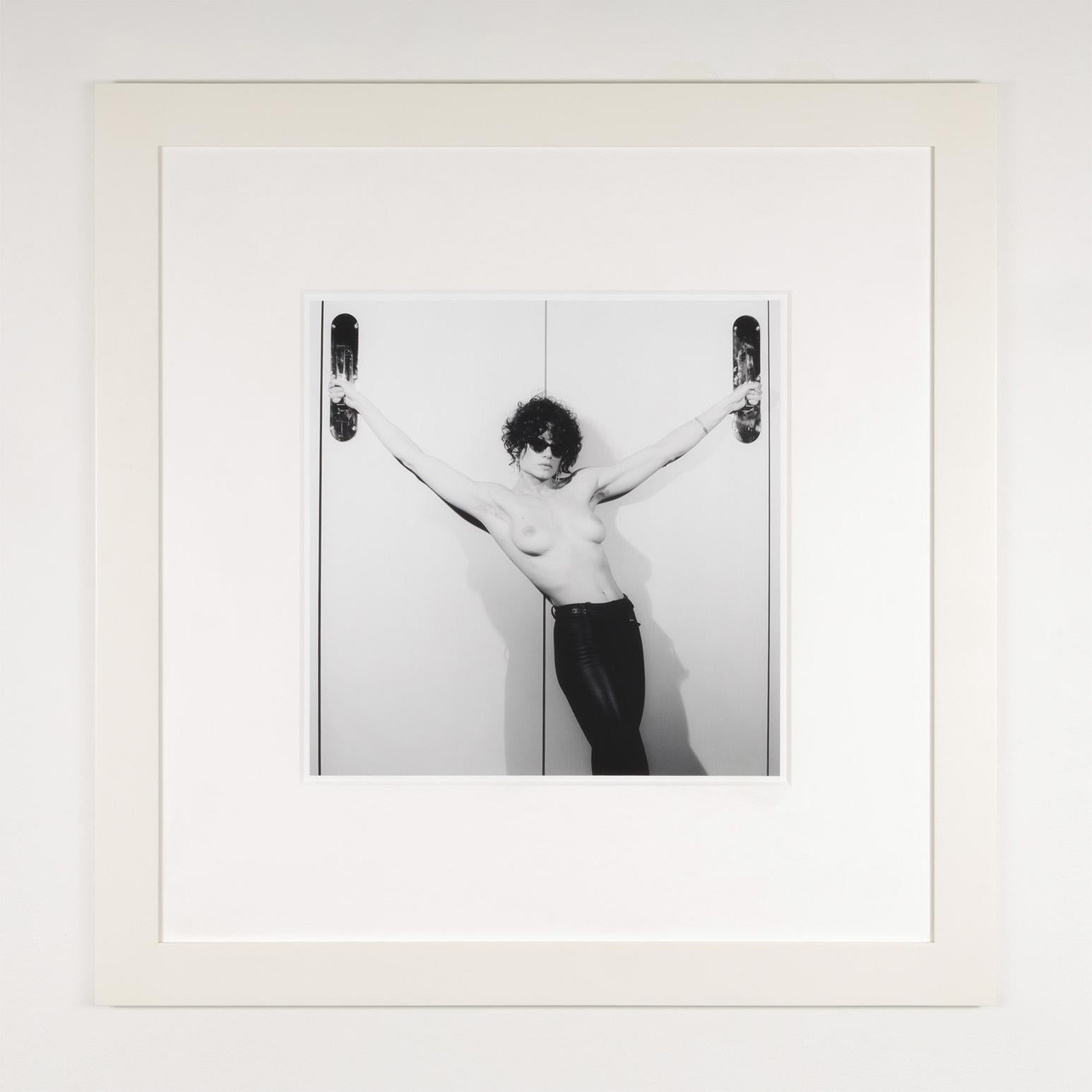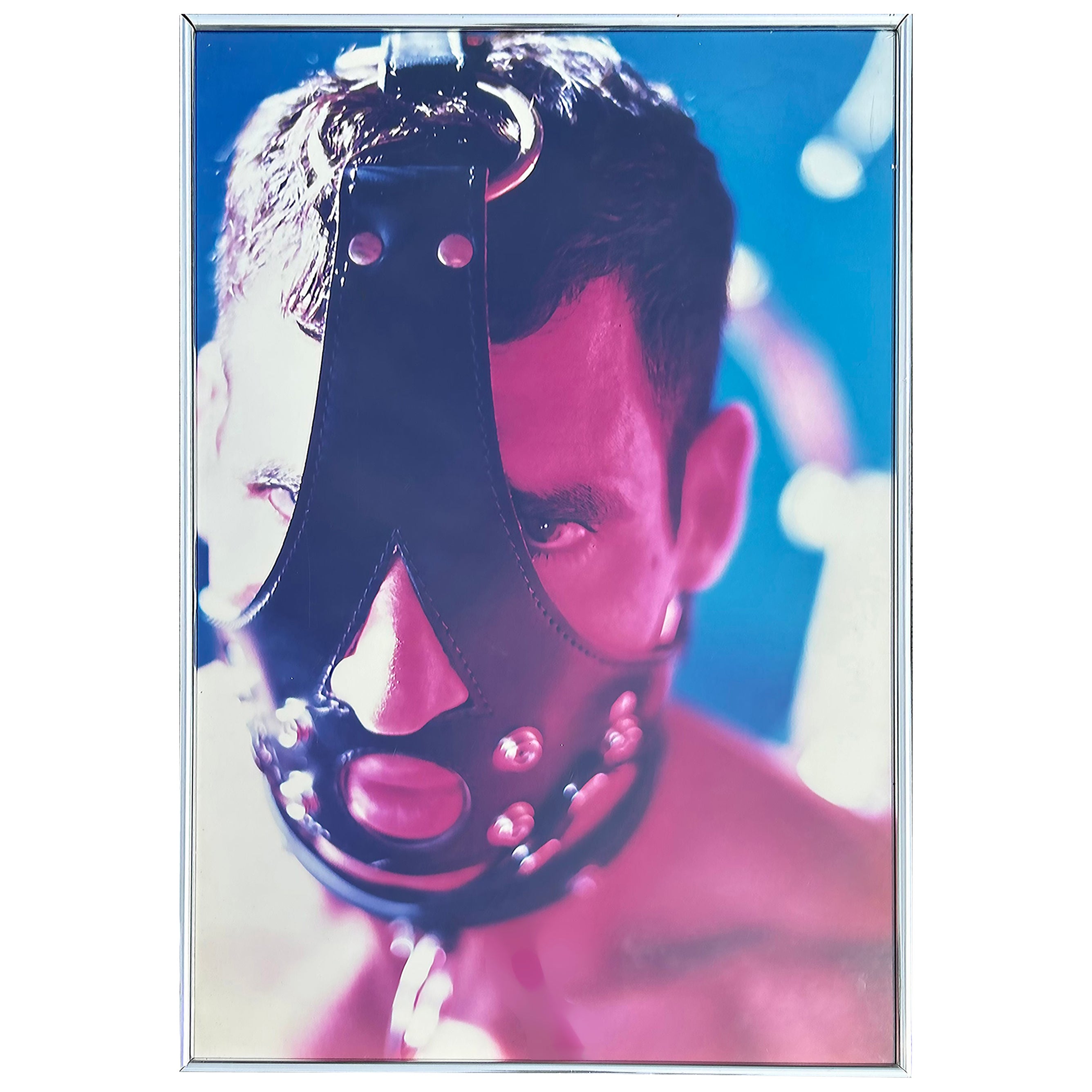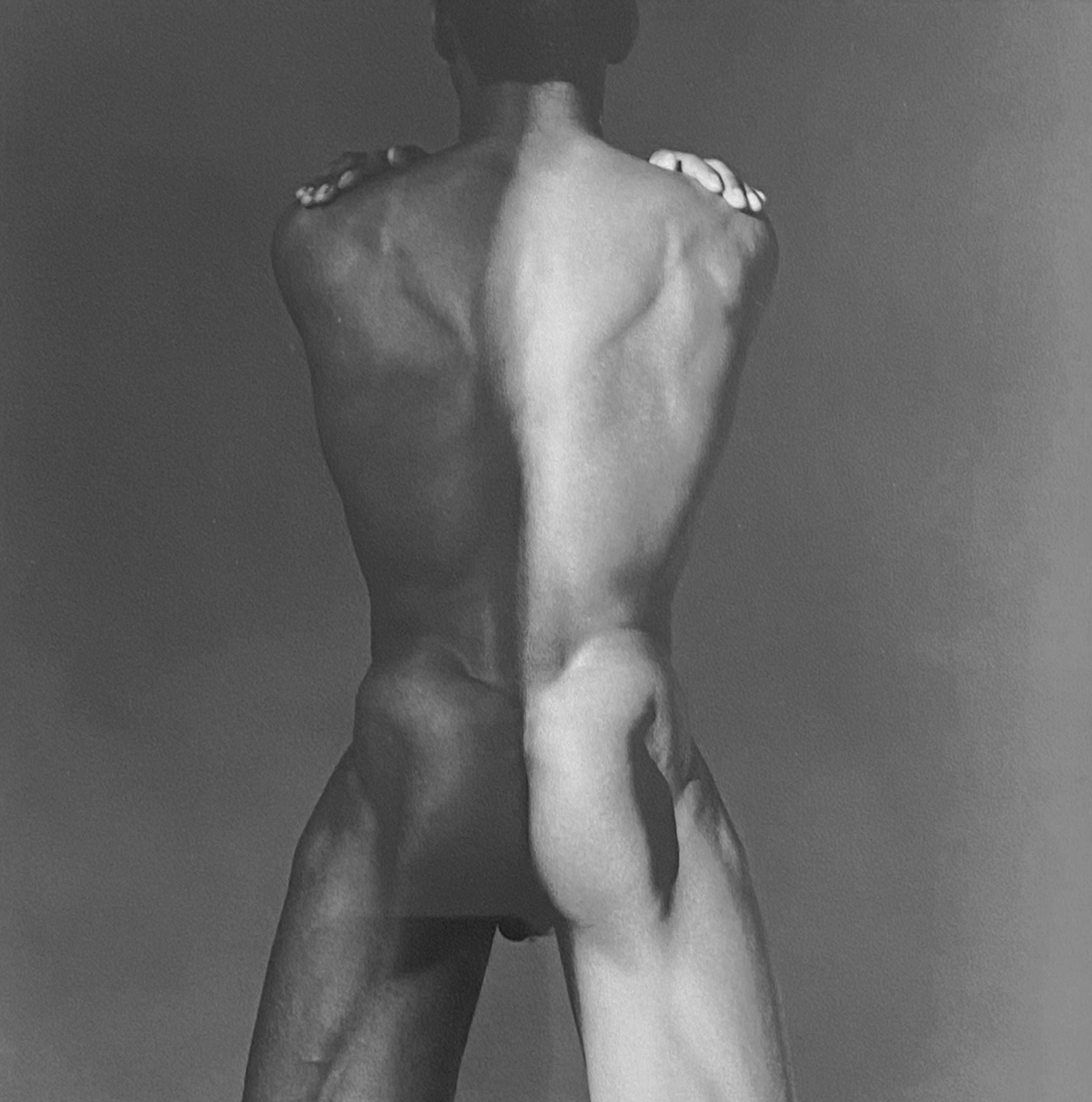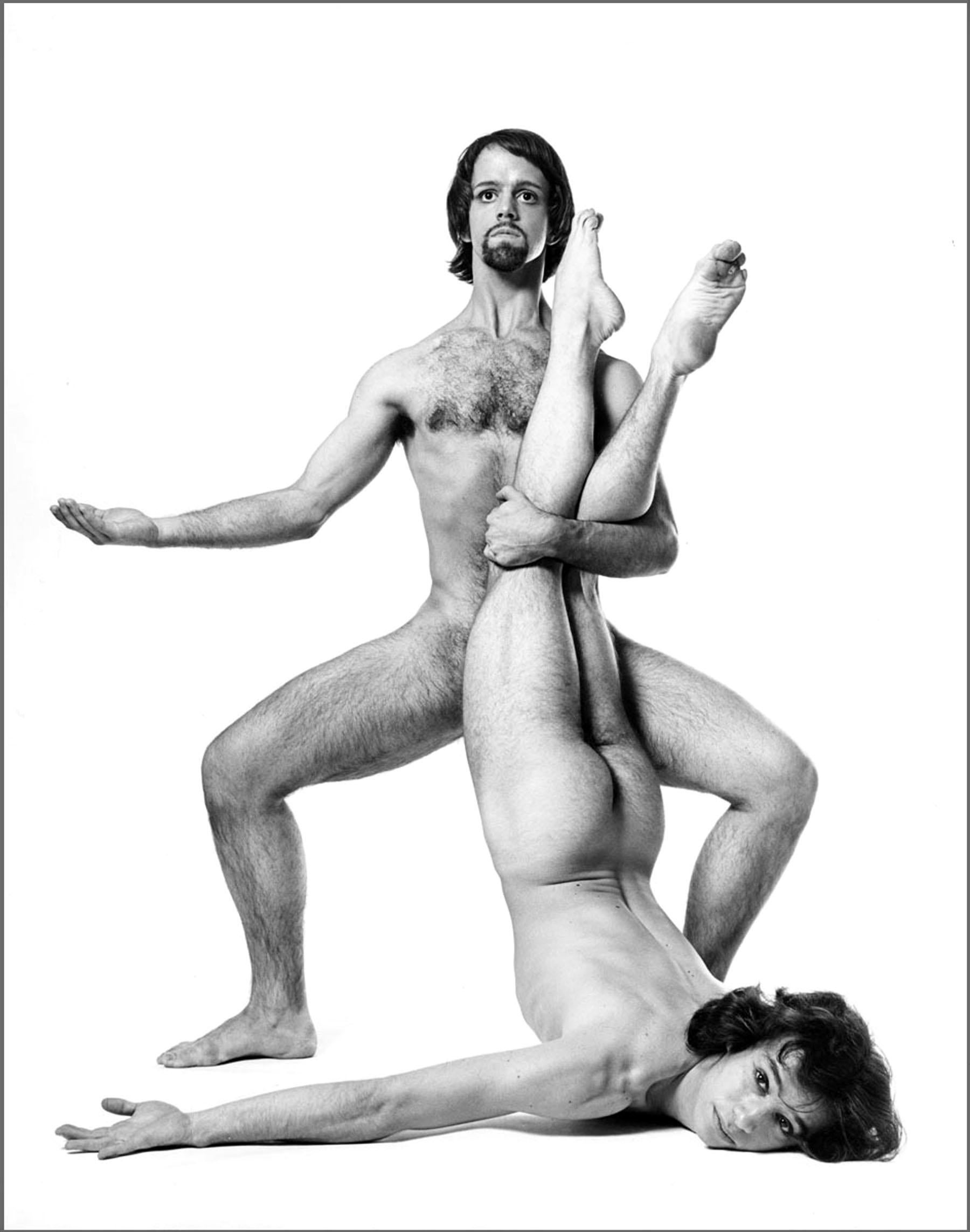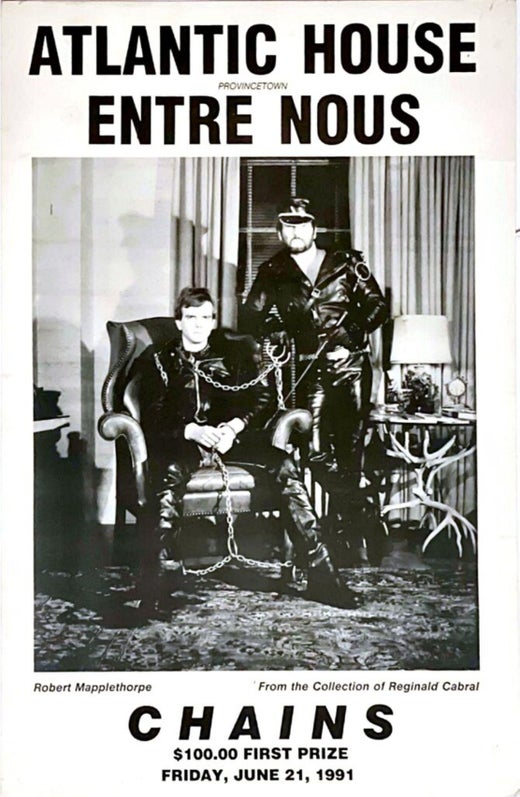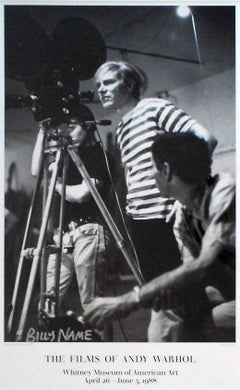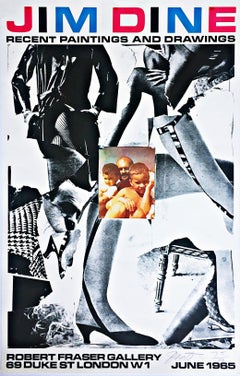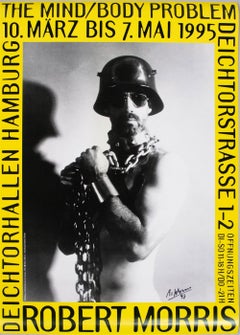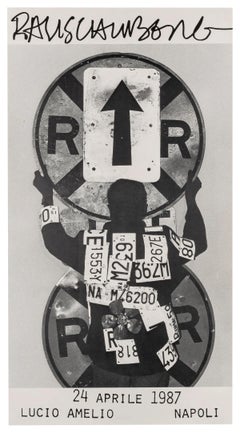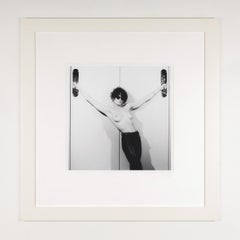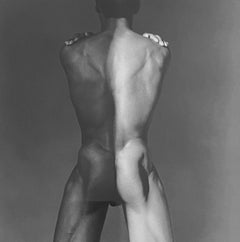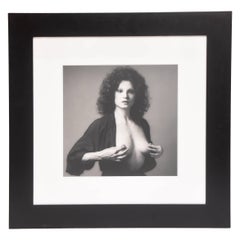Robert Mapplethorpe
Rare (Historic) Atlantic House, Provincetown - Entre Nous - Chains poster, 1991
Offset lithograph poster
17 × 11 inches
Unframed, unsigned and unnumbered
Accompanied by gallery issued Certificate of Guarantee
Collectors' item!
Extremely rare and collectible 1991 poster published on the occasion of the Chains exhibition at The Atlantic - America's oldest gay bar A truly coveted collectors' item, printed in Mapplethrope's lifetime making it more valuable. (The Atlantic House, or A-House, is the renowned Provincetown, Massachusetts institution considered by many to be the oldest gay bar in the United States. The Atlantic House was built in 1798 by Daniel Pease, Provincetown's first postmaster and was operated by him until his death in 1834. The building changed hands and names several times until 1871 when it was purchased by Frank Potter Smith and named Atlantic House, a name which has permanently stuck. During the 1920s, A-House was the hangout for writers like Eugene O'Neill and Tennessee Williams (a nude photo of Williams strolling on Provincetown beaches hangs in the bar), as well as any number of alternate-life stylists. In 1950, ownership was taken over by Reginald Cabral, and since then it has become both truly 'gay friendly' and the most popular watering hole in Provincetown. Since the early '50s, A-House has held weekly theme parties in the big room (their disco) and has had a dedicated Macho Room upstairs, a bar for 'Leather Men' and their admirers..)
The present poster was also included in an exhibition on the dialogue between Lynda Benglis and Robert Morris at Neon Parc, TCB Art Inc. and Sutton Gallery Project Space in Victoria, Australia.
The photograph depicted is Robert Mapplethorpe's "Brian Ridley and Lyle Heeter, 1979", depicting two leather-clad men in a living room interior, one seated in an arm chair and the other leaning beside it. The man in the armchair is handcuffed and shackled while his companion holds the chains. It is part of part of the ARTIST ROOMS collection acquired jointly by Tate with the National Galleries of Scotland. Below is a description of this work, courtesy of the Tate Gallery and the Mapplethorpe Foundation:
"Power and role play in Mapplethorpe’s double portrait
Two men pose for a photograph in their living room. The room is tastefully decorated with a select number of antiques and curtains that hang to the floor, forming a backdrop for a glass table top that balances on stag antlers. The couple are in costume; kitted out in full leather, they are dressed as real men. The younger of the two sits in an armchair; he plays The Slave. The chains that shackle him are controlled by his partner, whose boots rest firmly on an oriental carpet – the kind you buy from a specialist dealer – and who is also holding a crop that rests on the armchair. He is playing The Master. Together, they have rehearsed the gestures and motivations of their specific roles. They have collaboratively demarcated a safe space, having outlined their limits and agreed on a safe word.
In sitting for the picture, they have invited Mapplethorpe to join their game. He plays The Photographer, and his task is to frame their private role play and make it public. They adopt an air of relaxed formality in a similar manner to that which may be assumed by a certain type of family when posing for the annual portrait they send out to friends at Christmas. Like these domestic stagings, the two men are engaged in an act of exhibitionism. Yet here, the sitters are playfully aware of all the oppression and subservience involved in performing normative roles behind closed doors.
The resulting image implies a fourth participant: The Viewer. A new safe space is being attempted, but this time in public."
Robert Mapplethorpe Biography
Robert Mapplethorpe was born in 1946 in Floral Park, Queens. Of his childhood he said, "I come from suburban America. It was a very safe environment and it was a good place to come from in that it was a good place to leave."
In 1963, Mapplethorpe enrolled at Pratt Institute in nearby Brooklyn, where he studied drawing, painting, and sculpture. Influenced by artists such as Joseph Cornell and Marcel Duchamp, he also experimented with various materials in mixed-media collages, including images cut from books and magazines. In 1969, he and Patti Smith, whom he had met three years earlier, moved into the Chelsea Hotel.
Mapplethorpe acquired a Polaroid camera in 1970 from artist and filmmaker Sandy Daley and began producing his own photographs to incorporate into the collages, saying he felt "it was more honest." Mapplethorpe quickly found satisfaction taking Polaroid photographs, however, he rarely included them in his mixed-media works. In 1973, the Light Gallery in New York City mounted his first solo gallery exhibition, "Polaroids." Two years later, Sam Wagstaff, benefactor and mentor, gave Mapplethorpe a Hasselblad 500 camera and he began shooting his circle of friends and acquaintances—artists, musicians, socialites, film stars, and members of the S&M underground. He also worked on commercial projects, creating album cover art, including covers for Patti Smith and the band, “Television”, and a series of portraits and party pictures for Interview Magazine.
In the late 1970s, Mapplethorpe grew increasingly interested in documenting the New York S&M scene. The resulting photographs are shocking for their content and remarkable for their technical and formal mastery. Mapplethorpe told ARTnews in late 1988, "I don't like that particular word 'shocking.' I'm looking for the unexpected. I'm looking for things I've never seen before…I was in a position to take those pictures. I felt an obligation to do them." His career continued to flourish. In 1977, he participated in Documenta 6 in Kassel, West Germany and in 1978, the Robert Miller Gallery in New York City became his exclusive dealer.
Mapplethorpe met Lisa Lyon, the first World Women's Bodybuilding Champion, in 1980. Over the next several years they collaborated on a series of portraits and figure studies, a film, and the book, Lady: Lisa Lyon. Throughout the 1980s, Mapplethorpe produced images that simultaneously challenge and adhere to classical aesthetic standards: stylized compositions of male and female nudes, delicate flowers and still lifes, studio portraits of artists and celebrities, to name a few of his preferred genres. He introduced and refined different techniques and formats, including color 20 x 24 inch Polaroids, photogravures, platinum prints on paper and linen, Cibachrome and dye transfer color prints. In 1986, he designed sets for Lucinda Childs' dance performance, Portraits in Reflection, created a photogravure series for Arthur Rimbaud’s A Season in Hell, and was commissioned by curator Richard Marshall to take portraits of New York artists for the book, 50 New York Artists.
That same year, in 1986, Mapplethorpe was diagnosed with AIDS. Despite his illness, he accelerated his creative efforts, broadened the scope of his photographic inquiry, and accepted increasingly challenging commissions. The Whitney Museum of American Art mounted his first major American museum retrospective in 1988, the year before his death in 1989.
His vast, provocative, and powerful body of work has established him as one of the most important artists of the twentieth century. Today, Mapplethorpe is represented by galleries in North and South America, Europe and Asia and his work can be found in the collections of major museums around the world. Beyond the art historical and cultural significance of his work, his legacy lives on through the work of the Robert Mapplethorpe Foundation. He established the Foundation in 1988 to promote photography, support museums that exhibit photographic art, and to fund medical research in the fight against HIV/AIDS.
-Courtesy The Robert Mapplethorpe Foundation
